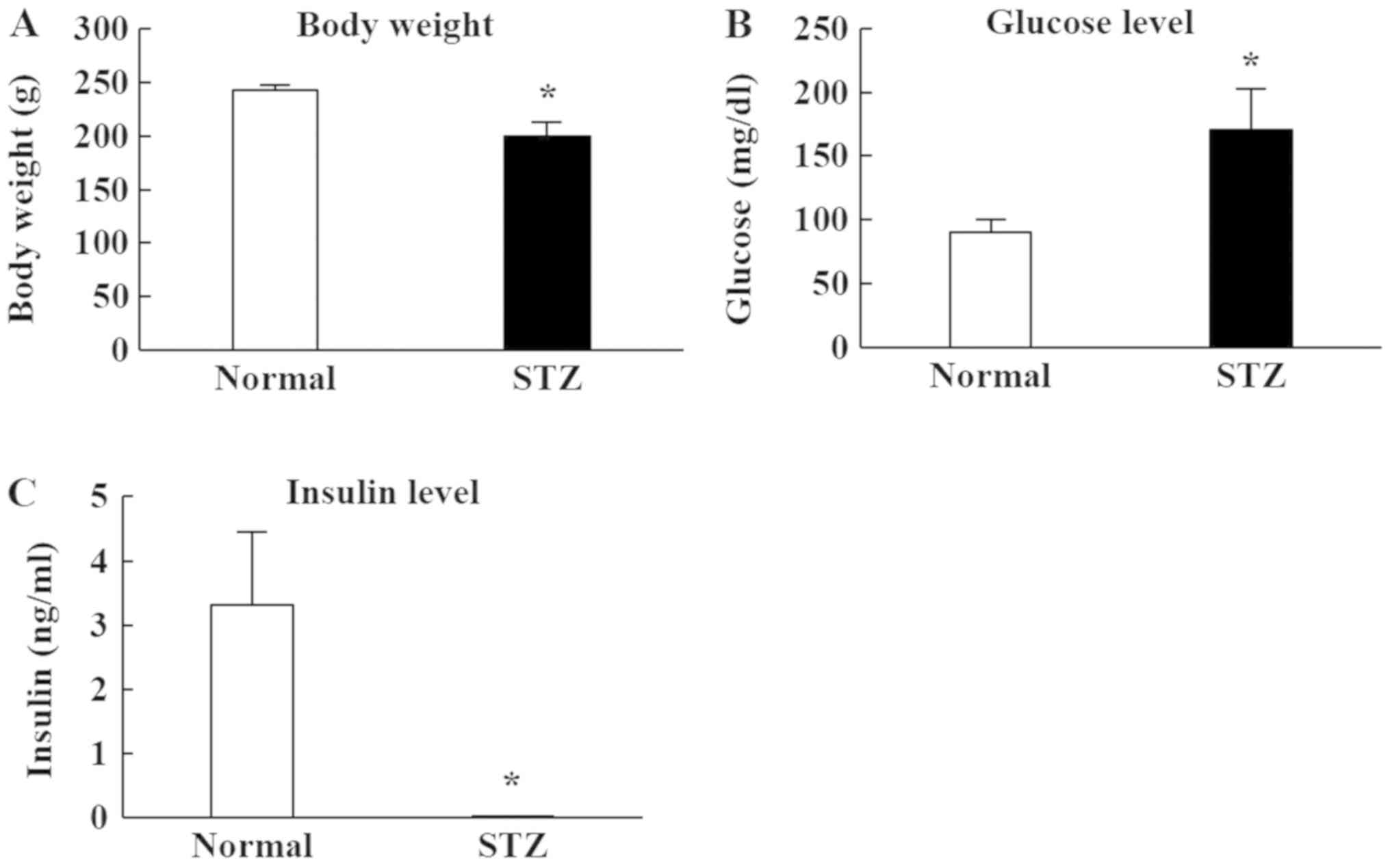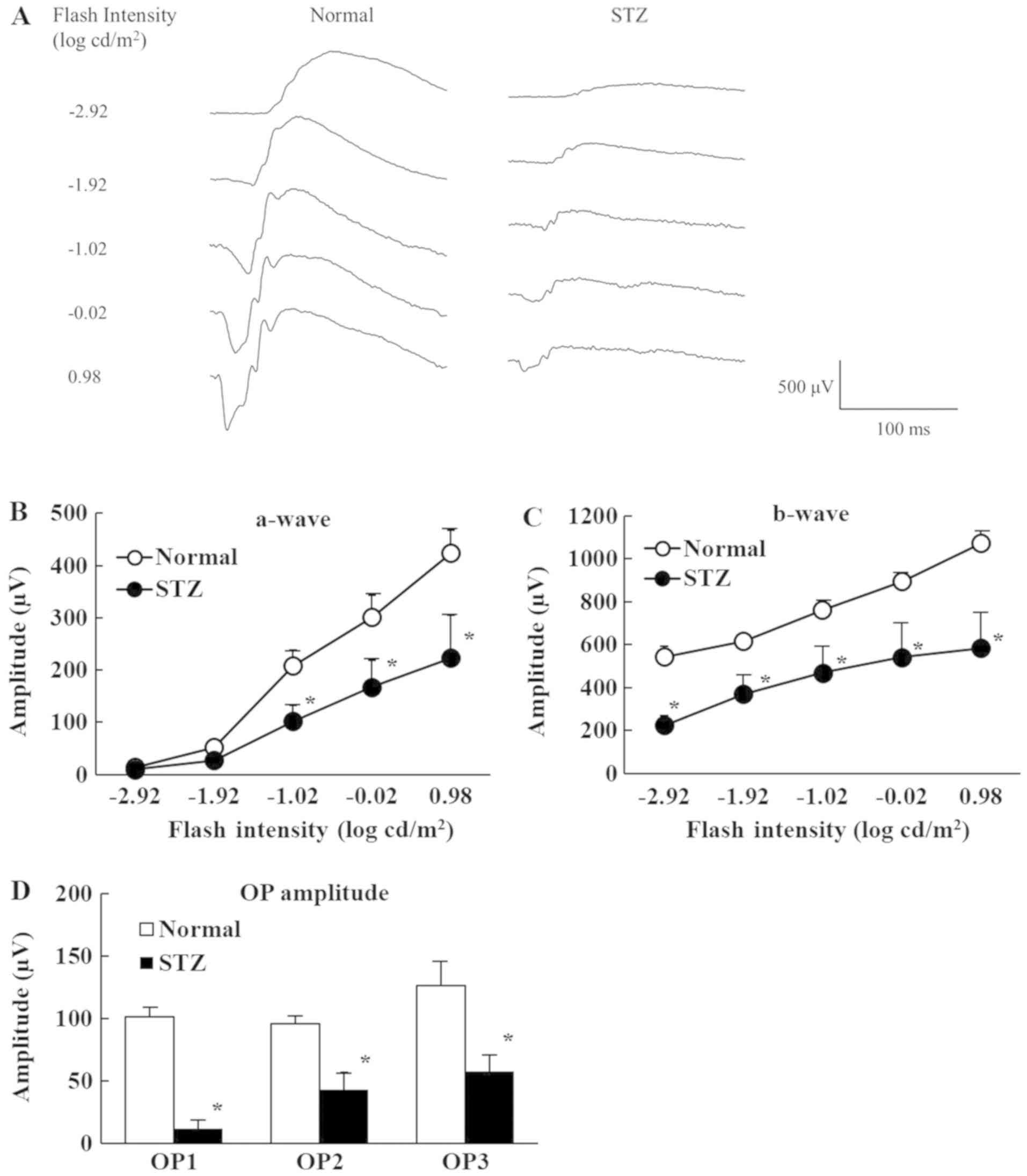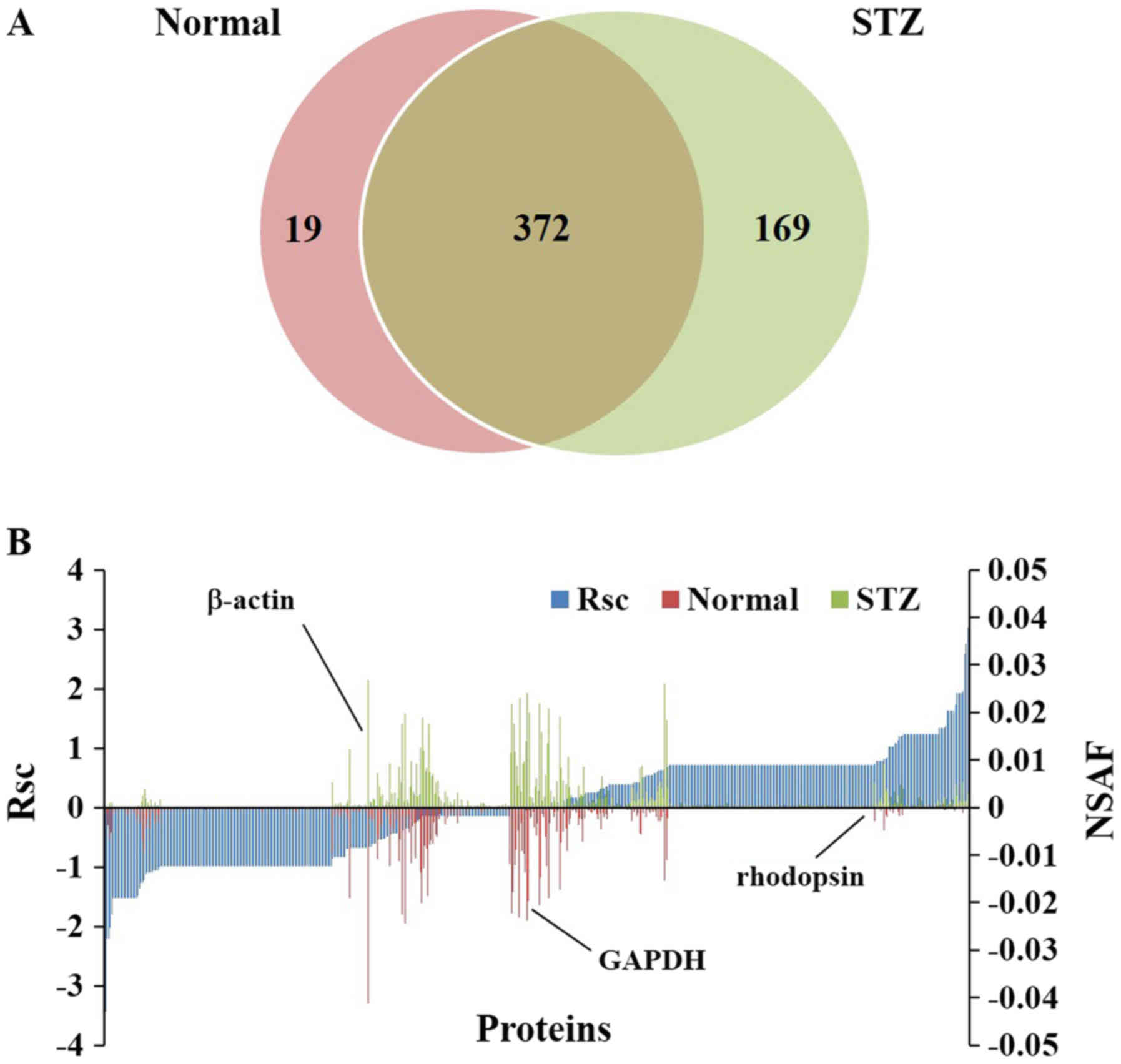|
1
|
Radenković M, Stojanović M and Prostan M:
Experimental diabetes induced by alloxan and streptozotocin: The
current state of the art. J Pharmacol Methods. 78:13–31. 2016.
View Article : Google Scholar
|
|
2
|
Goyal SN, Reddy NM, Patil KR, Nakhate KT,
Ojha S, Patil CR and Agrawal YO: Challenges and issues with
streptozotocin-induced diabetes-A clinically relevant animal model
to understand the diabetes pathogenesis and evaluate therapeutics.
Chem Biol Interact. 244:49–63. 2016. View Article : Google Scholar : PubMed/NCBI
|
|
3
|
Liu CH, Wang Z, Sun Y and Chen J: Animal
models of ocular angiogenesis: From development to pathologies.
FASEB J. 31:4665–4681. 2017. View Article : Google Scholar : PubMed/NCBI
|
|
4
|
Nagai N, Deguchi S, Otake H, Hiramatsu N
and Yamamoto N: Therapeutic effect of cilostazol ophthalmic
nanodispersions on retinal dysfunction in streptozotocin-induced
diabetic rats. Int J Mol Sci. 18(pii): E19712017. View Article : Google Scholar : PubMed/NCBI
|
|
5
|
Deguchi S, Otake H, Nakazawa Y, Hiramatsu
N, Yamamoto N and Nagai N: Ophthalmic formulation containing
nilvadipine nanoparticles prevents retinal dysfunction in rats
injected with streptozotocine. Int J Mol Sci. 18(pii): E27202017.
View Article : Google Scholar : PubMed/NCBI
|
|
6
|
Hiramatsu N, Deguchi S, Yoshioka C, Otake
H, Yamamoto N and Nagai N: Evaluation of retinal function in
streptozotocin-induced diabetic rats by using the
electroretinography and immunohistochemistry methods. Yakugaku
Zasshi. 137:1169–1175. 2017.(In Japanese). View Article : Google Scholar : PubMed/NCBI
|
|
7
|
Gopalakrishnan V, Purushothaman P and
Bhaskar A: Proteomic analysis of plasma proteins in diabetic
retinopathy patients by two dimensional electrophoresis and
MALDI-Tof-MS. J Diabetes Complications. 29:928–936. 2015.
View Article : Google Scholar : PubMed/NCBI
|
|
8
|
Joseph R, Srivastava OP and Pfister RR:
Differential epithelial and stromal protein profiles in keratoconus
and normal human corneas. Exp Eye Res. 92:282–298. 2011. View Article : Google Scholar : PubMed/NCBI
|
|
9
|
Yamamoto T, Kudo M, Peng WX and Naito Z:
Analysis of protein expression regulated by lumican in PANC-1 cells
using shotgun proteomics. Oncol Rep. 30:1609–1621. 2013. View Article : Google Scholar : PubMed/NCBI
|
|
10
|
Meade ML, Shiyanov P and Schlager JJ:
Enhanced detection method for corneal protein identification using
shotgun proteomics. Proteome Sci. 7:232009. View Article : Google Scholar : PubMed/NCBI
|
|
11
|
Nagai N, Yamamoto T, Mitamura K and Taga
A: Proteomic profile of the lens in a streptozotocin-induced
diabetic rat model using shotgun proteomics. Biomed Rep. 7:445–450.
2017. View Article : Google Scholar : PubMed/NCBI
|
|
12
|
Yammoto T, Otake H, Hiramatsu N, Yamamoto
N, Taga A and Nagai N: A proteomic approach for understanding the
mechanisms of delayed corneal wound healing in diabetic keratopathy
using diabetic model rat. Int J Mol Sci. 19(pii): E36352018.
View Article : Google Scholar : PubMed/NCBI
|
|
13
|
Ma DH, Lai JY, Yu ST, Liu JY, Yang U, Chen
HC, Yeh LK, Ho YJ, Chang G, Wang SF, et al: Up-regulation of heat
shock protein 70-1 (Hsp70-1) in human limbo-corneal epithelial
cells cultivated on amniotic membrane: A proteomic study. J Cell
Physiol. 227:2030–2039. 2012. View Article : Google Scholar : PubMed/NCBI
|
|
14
|
Nagai N, Ito Y and Sasaki H: Hyperglycemia
enhances the production of amyloid β1–42 in the lenses of otsuka
long-evans tokushima fatty rats, a model of human type 2 diabetes.
Invest Ophth Vis Sci. 57:1408–1417. 2016. View Article : Google Scholar
|
|
15
|
Bluemlein K and Ralser M: Monitoring
protein expression in whole-cell extracts by targeted label- and
standard-free LC-MS/MS. Nat Protoc. 6:859–869. 2011. View Article : Google Scholar : PubMed/NCBI
|
|
16
|
Old WM, Meyer-Arendt K, Aveline-Wolf L,
Pierce KG, Mendoza A, Sevinsky JR, Resing KA and Ahn NG: Comparison
of label-free methods for quantifying human proteins by shotgun
proteomics. Mol cell Proteom. 4:1487–1502. 2005. View Article : Google Scholar
|
|
17
|
Zybailov B, Coleman MK, Florens L and
Washburn MP: Correlation of relative adundance ratios derived from
peptide ion chromatograms and spectrum counting for quantitative
proteomic analysis using stable isotope labeling. Anal Chem.
77:6218–6224. 2005. View Article : Google Scholar : PubMed/NCBI
|
|
18
|
Dennis G Jr, Sherman BT, Hosack DA, Yang
J, Gao W, Lane HC and Lempicki RA: DAVID: Database for annotation,
visualization, and integrated discovery. Genome Biol. 4:P32003.
View Article : Google Scholar : PubMed/NCBI
|
|
19
|
Huang da W, Sherman BT and Lempicki RA:
Systematic and integrative analysis of large gene lists using DAVID
bioinformatics resources. Nat Protoc. 4:44–57. 2009. View Article : Google Scholar : PubMed/NCBI
|
|
20
|
Huang da W, Sherman BT, Zheng X, Yang J,
Inamichi T, Stephens R and Lempicki RA: Extracting biological
meaning from large gene lists with DAVID. Curr Protoc
Bioinformatics. Chapter 13: Unit 13.11. 2009, View Article : Google Scholar
|
|
21
|
Stephen Irudayaraj S, Sunil C,
Duraipandiyan V and Ignacimuthu S: Antidiabetic and antioxidant
activities of Toddalia asiatica (L.) Lam. Leaves in streptozotocin
induced diabetic rats. J Ethnopharmacol. 143:515–523. 2012.
View Article : Google Scholar : PubMed/NCBI
|
|
22
|
Nisha P and Mini S: Flavanoid rich ethyl
acetate fraction of Musa paradisiaca inflorescence down-regulates
the streptozotocin induced oxidative stress, hyperglycemia and mRNA
levels of selected inflammatory genes in rats. J Funct Food.
5:1838–1847. 2013. View Article : Google Scholar
|
|
23
|
Miller JW, Adamis AP and Aiello LP:
Vascular endothelial growth factor in ocular neovascularization and
proliferative diabetic retinopathy. Diabetes Metab Rev. 13:37–50.
1997. View Article : Google Scholar : PubMed/NCBI
|
|
24
|
Cheung N and Wong TY: Diabetic retinopathy
and systemic vascular complications. Prog Retin Eye Res.
27:161–176. 2008. View Article : Google Scholar : PubMed/NCBI
|
|
25
|
Cheung N, Mitchell P and Wong TY: Diabetic
retinopathy. Lancet. 376:124–136. 2010. View Article : Google Scholar : PubMed/NCBI
|
|
26
|
Barber AJ, Lieth E, Khin SA, Antonetti DA,
Buchanan AG and Gardner TW: Neural apoptosis in the retina during
experimental and human diabetes. J Clin Invest. 102:783–791. 1998.
View Article : Google Scholar : PubMed/NCBI
|
|
27
|
Lecleire-Collet A, Audo I, Aout M, Girmens
JF, Sofroni R, Erginary A, Gargasson JF, Mohand-Saïd S, Meas T,
Guillausseau PJ, et al: Evaluation of retinal function and flicker
light-induced retinal vascular response in normotensive patients
with diabetes without retinopathy. Invest Ophthalmol Vis Sci.
52:2861–2867. 2011. View Article : Google Scholar : PubMed/NCBI
|
|
28
|
Hancock HA and Kraft TW: Oscillatory
potential analysis and ERGs of normal and diabetic rats. Invest
Ophthalmol Vis Sci. 45:1002–1008. 2004. View Article : Google Scholar : PubMed/NCBI
|
|
29
|
Layton CJ, Safa R and Osbrme NN:
Oscillatory potentials and the b-wave: Partial masking and
interdependence in dark adaptation and diabetes in the rat. Graefes
Arch Clin Exp Ophthalmol. 245:1335–1345. 2007. View Article : Google Scholar : PubMed/NCBI
|
|
30
|
Samuels IS, Bell BA, Pereira A, Saxon J
and Peachey NS: Early retinal pigment epithelium dysfunction is
concomitant with hyperglycemia in mouse models of type 1 and type 2
diabetes. J Neurophysiol. 113:1085–1099. 2015. View Article : Google Scholar : PubMed/NCBI
|
|
31
|
Yamamoto T, Kudo M, Peng WX and Naito Z:
Analysis of protein expression regulated by lumican in PANCc-1
cells using shotgun proteomics. Oncol Rep. 30:1609–1621. 2013.
View Article : Google Scholar : PubMed/NCBI
|
|
32
|
Takaya A, Peng WX, Ishino K, Kudo M,
Yamamoto T, Wada R, Takeshita T and Naito Z: Cystatin B as a
potential diagnostic biomarker in ovarian clear cell carcinoma. Int
J Oncol. 46:1573–1581. 2015. View Article : Google Scholar : PubMed/NCBI
|
|
33
|
Kanzaki A, Kudo M, Ansai S, Peng WX,
Ishino K, Yamamoto T, Wada R, Fujii T, Teduka K, Kawahara K, et al:
Insulin-like growth factor 2 mRNA-binding protein-3 as a marker for
distinguishing between cutaneous squamous cell carcinoma and
keratoacanthoma. Int J Oncol. 48:1007–1015. 2016. View Article : Google Scholar : PubMed/NCBI
|
|
34
|
Yamamoto T, Kudo M, Peng WX, Takata H,
Takakura H, Teduka K, Fujii T, Mitamura K, Taga A, Uchida E and
Naito Z: Identification of aldolase A as a potential diagnostic
biomarker for colorectal cancer based on proteomic analysis using
formalin-fixed paraffin-embedded tissue. Tumor Biol.
37:13595–13606. 2016. View Article : Google Scholar
|
|
35
|
Takata H, Kudo M, Yamamoto T, Ueda J,
Ishino K, Peng WX, Wada R, Taniai N, Yoshida H, Uchida E and Naito
Z: Increased expression of PDIA3 and its association with cancer
cell proliferation and poor prognosis in hepatocellular carcinoma.
Oncol Lett. 12:4896–4904. 2016. View Article : Google Scholar : PubMed/NCBI
|
|
36
|
Saari JC: Biochemistry of visual pigment
regeneration: The Friedenwald lecture. Investig Ophthalmol Vis Sci.
41:337–348. 2000.
|
|
37
|
Maeda A, Golczak M, Chen Y, Okano K, Kohno
H, Shiose S, Ishikawa K, Harte W, Palczewska G, Maeda T and
Palczewski K: Primary amines protect against retinal degeneration
in mouse models of retinopathies. Nat Chem Biol. 8:170–178. 2011.
View Article : Google Scholar : PubMed/NCBI
|
|
38
|
Lai Y, Wiggert B, Liu Y and Chader G:
Interphotoreceptor retinol-binding proteins: Possible transport
vehicles between compartments of the retina. Nature. 26:848–849.
1982. View Article : Google Scholar
|
|
39
|
Lin ZS, Fong S and Bridges CD: Retinoids
bound to interstitial retinol-binding protein during light and
dark-adaptation. Vision Res. 29:1699–1709. 1989. View Article : Google Scholar : PubMed/NCBI
|
|
40
|
Chen C, Adler L IV, Goletz P,
Gonzalez-Femandez F, Thompson DA and Koutalos Y: Interphotoreceptor
retinoid-binding protein removes all-trans-retinol and retinal from
rod outer segments, preventing lipofscin precursor formation. J
Biol Chem. 292:19356–19365. 2017. View Article : Google Scholar : PubMed/NCBI
|
|
41
|
Bascom RA, Manara S, Collins L, Molday RS,
Kalnins VI and Mclnnes RR: Cloning of the cDNA for a novel
photoreceptor membrane protein (rom-1) identifies a disk rim
protein family implicated in human retinopathies. Neuron.
8:1171–1184. 1992. View Article : Google Scholar : PubMed/NCBI
|
|
42
|
Bascom RA, Liu L, Humphries P, Fishman GA,
Murray JC and Mclnnes RR: Polymorphisms and rare sequence variants
at the ROM1 locus. Hum Mol Genet. 2:1975–1977. 1993. View Article : Google Scholar : PubMed/NCBI
|
|
43
|
Loewen CJ and Molday RS:
Disulfide-mediated oligomerization of Peripherin/Rds and Rom-1 in
photoreceptor disk membranes. Implications for photoreceptor outer
segment morphogenesis and degeneration. J Biol Chem. 275:5370–5378.
2000. View Article : Google Scholar : PubMed/NCBI
|
|
44
|
Clarke G, Goldberg AF, Vidgen D, Collins
L, Ploder L, Schwarz L, Molday LL, Rossant J, Szél A, Molday RS, et
al: Rom-1 is required for rod photoreceptor viability and the
regulation of disk morphogenesis. Nat Genet. 25:67–73. 2000.
View Article : Google Scholar : PubMed/NCBI
|
|
45
|
Yamamoto T, Nishita T and Taga A:
Dark-colored maple syrup treatment induces S-phase cell cycle
arrest via reduced proliferating cell nuclear antigen expression in
colorectal cancer cells. Oncol Lett. 17:2713–2720. 2019.PubMed/NCBI
|
|
46
|
Yamamoto T, Nakanishi S, Mitamura K and
Taga A: Collagen peptides from soft-shelled turtle induce calpain-1
expression and regulate inflammatory cytokine expression in HaCaT
human skin keratinocytes. Int J Mol Med. 42:1168–1180.
2018.PubMed/NCBI
|

















